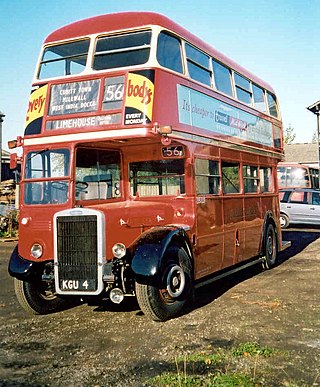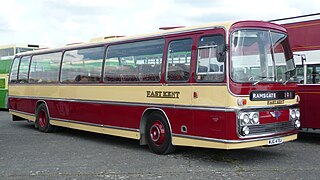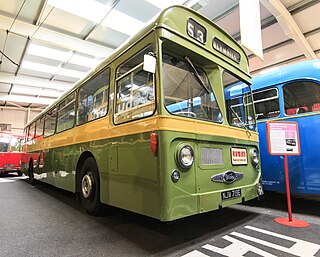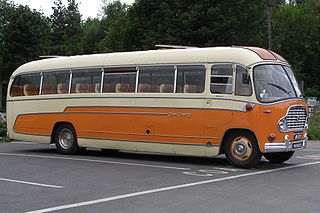
The Leyland Titan was a forward-control chassis with a front-mounted engine designed to carry double-decker bus bodywork. It was built mainly for the United Kingdom market between 1927 and 1942, and between 1945 and 1969.

Duple Coachbuilders was a coach and bus bodybuilder in England from 1919 until 1989.

The Bristol VR was a rear-engined double-decker bus chassis which was manufactured by Bristol Commercial Vehicles as a competitor to the Leyland Atlantean and Daimler Fleetline.

The Leyland Leopard was a mid-engined single-decker bus and single-decker coach chassis manufactured by Leyland between 1959 and 1982.

Bristol Commercial Vehicles was a vehicle manufacturer located in Bristol, England. Most production was of buses but trucks and railbus chassis were also built.

The Plaxton Panorama Elite was a successful design of coach bodywork built between 1968 and 1975 by Plaxton of Scarborough, Yorkshire, England. A wide-doorway variant called the Plaxton Elite Express was also built. Collectively, they are commonly referred to as the Plaxton Elite.

The Duple Dominant was a design of a coach bodywork built by Duple between 1972 and 1987. It introduced an all-steel structure and replaced the wooden-framed Duple Vega, Viceroy and Vista models.
Eastern Coach Works was a bus and train bodybuilder based in Lowestoft, England.

The Bristol RE was a rear-engined single-decker bus or single-decker coach chassis built by Bristol Commercial Vehicles from 1962 until 1982. It is often considered the most successful of the first generation of rear-engined single-decker buses.

The Leyland Tiger Cub was a lightweight underfloor-engined chassis manufactured by Leyland between 1952 and 1970.

The Daimler Roadliner was a single-decker bus and coach chassis built by Daimler between 1962 and 1972. Notoriously unreliable, it topped the 1993 poll by readers of Classic Bus as the worst bus type ever, beating the Guy Wulfrunian into second place. It was very technologically advanced, offering step-free access some 20 years before other buses; as a coach, it was felt by industry commentators to be in advance of contemporary UK designs.
The Albion Aberdonian was an underfloor-engined bus designed and manufactured by Albion Motors between 1957 and 1960, it was introduced as a longer derivative of the Albion Nimbus.

The Albion Nimbus was an underfloor-engined, ultra-lightweight midibus or coach chassis, with a four-cylinder horizontal diesel engine and a gross vehicle weight of six tons. It was largely operated on light rural bus duties and private hires. Operators who used it on heavy-duty bus routes found it insufficiently robust. It was the first Albion bus chassis to have a name that did not begin with the letter V. The design was revised twice and was produced from 1955 to 1965.

The Bedford SB was a front-engined bus chassis manufactured by Bedford in England. It was launched at the 1950 Commercial Motor Show as the replacement for the Bedford OB.
The Seddon Pennine RU was a rear-engined single-decker bus built by Seddon Diesel Vehicles/Seddon Atkinson between 1969 and 1974.

The Seddon Pennine 7 was a mid-underfloor-engined single-deck bus or coach chassis built by Seddon Atkinson between 1974 and 1982.

The Leyland Royal Tiger Worldmaster, sometimes simply known as the Leyland Worldmaster, was a mid-underfloor-engined single-decker bus or single-decker coach chassis manufactured by Leyland between 1954 and 1979.

Open top buses in Weston-super-Mare, Somerset, England, were introduced in 1950 and have run along the sea front most summers since. The initial operator was Bristol Tramways and this company's successors continued to provide services until 2013. The route from Weston-super-Mare railway station to Sand Bay is operated by First West of England. From time-to-time open top buses have also provided scenic tours in and around the town.

The Bristol SU was a single-decker bus and single-decker coach chassis built by Bristol Commercial Vehicles between 1960 and 1966. The bodies for these vehicles were built by Eastern Coach Works (ECW). Some of them were built as medium length chassis, whereas most of them were built as full length chassis.

The Leyland Royal Tiger PSU was an underfloor-engined bus and coach chassis manufactured by Leyland between 1950 and 1954.

























